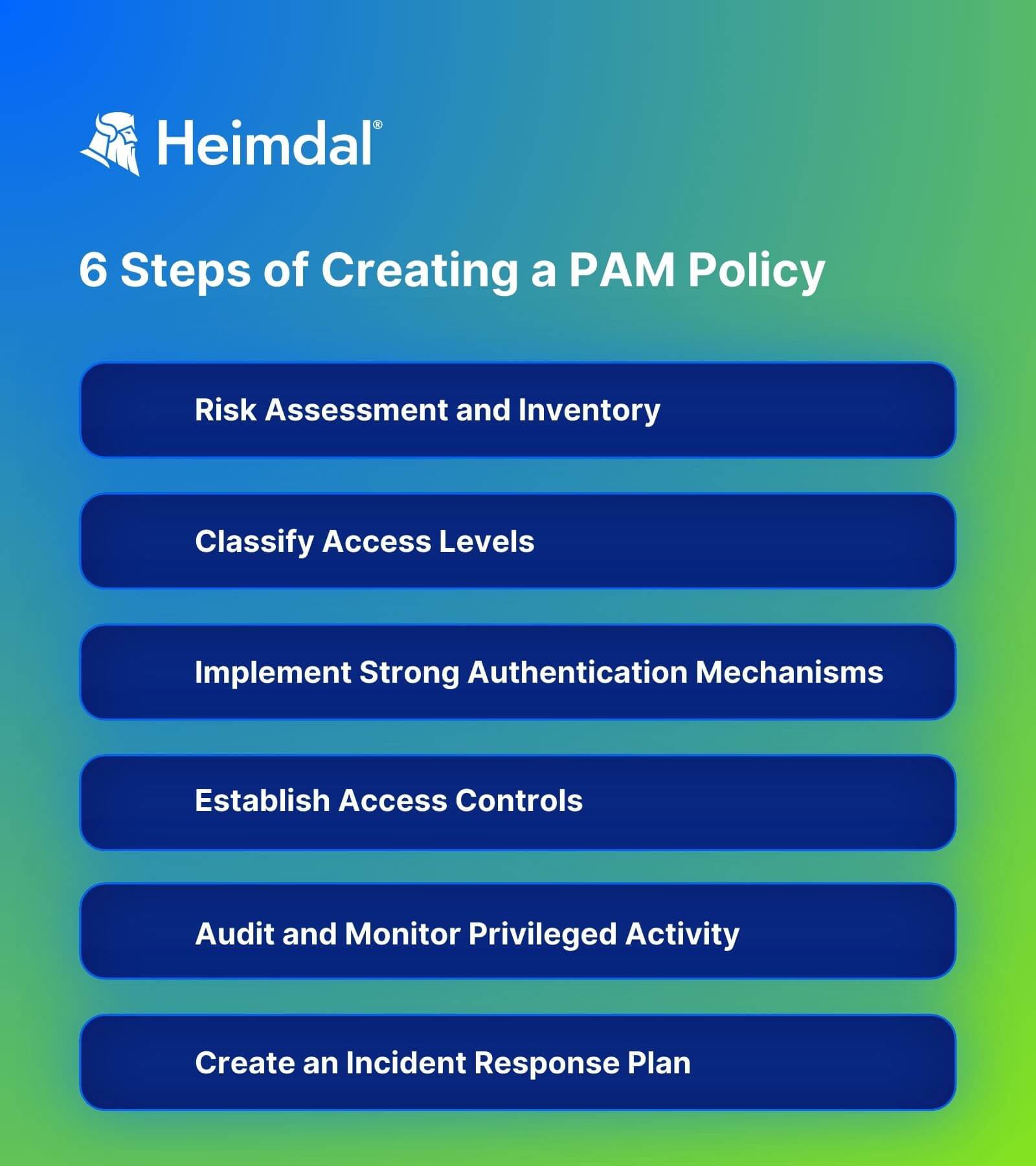Contents:
A Privileged Access Management policy is a set of rules that controls who and how can use privileged access.
It is usually set through a privileged access management solution and aims to protect sensitive information and prevent unauthorized access. It defines roles within your organization and outlines required privileges and access rights for each.
Key takeaways
- Main components of a PAM policy
- How to create a Privileged Access Management policy
- What are the most common rules in PAM policies
- Benefits of PAM policies
- Challenges of the Implementation process
Main Components of the Privileged Access Management Policy
Privileged access management policies typically include the following components:
- Access control lists that specify which users are authorized to access which resources.
- Authentication mechanisms that check the identity of privileged users before they are granted access. The System Administrator should only assign a privileged account to a specific user, with a unique username and password.
If two or more users need access to a specific privileged account, they should create a shared credentials system. In this case, the system administrator will first create a privileged passwords storage system and will set the rules for a password policy.
- Authorization rules that dictate what users are allowed to do with the resources they have been granted access to.
- Audit trails that track user activity and identify any unauthorized access attempts.
- Security measures that restrict physical access to systems and data.
How to Create a Privileged Access Management Policy

Writing down a formal policy for privileged accounts is just one of the PAM best practices. The PAM policy should match the needs of your IT environment, regulatory requirements, and organizational structure. Further on, all IT team members, executives, and auditors should be able to access the final document.
To start building your own, customized privileged access management policy, follow the step-by-step guide below.
Risk Assessment and Inventory
Begin by conducting a thorough risk assessment. Identify all privileged accounts, including administrator accounts, service accounts, and emergency accounts. Understand where they exist, how they are used, and the potential risks associated with each.
Classify Access Levels
Not all privileged accounts need the same level of access. Classify them based on their roles and responsibilities. This will help you apply the principle of least privilege—ensuring users have just enough access to do their jobs. Only elevate privileges for those users that really need to access databases, for example.
Implement Strong Authentication Mechanisms
For privileged accounts, passwords alone are not enough. Implement multi-factor authentication (MFA) to add an extra layer of security.
Establish Access Controls
Use a robust system for granting, revoking, and reviewing privileged access. Temporary or time-bound access can be beneficial for reducing the risk window.
Audit and Monitor Privileged Activity
Regularly audit privileged activities and monitor in real-time. This not only helps in detecting potential breaches but also in understanding normal versus abnormal behaviors. Additionally, auditing is important for meeting compliance goals.
Create an Incident Response Plan
Have a clear response plan for when things go wrong. This should include steps for containing breaches, assessing impact, and preventing future incidents.
Most Common Rules in PAM Policies
Each organization should build its own, custom set of rules and procedures regarding privileged access. One size does not fit all in cybersecurity. However, there is a set of mandatory PAM best practices you should include in your PAM policy. Here is a PAM policies checklist I made for you:
Principle of the Least Privilege
Limit privileged user IDs to those employees who absolutely need such privileges to accomplish their tasks. According to the Principle of the Least Privilege (PoLP) users should only have enough access and rights to be able to do their jobs.
Dual approval
Only allow creating or modifying privileged user accounts based on a dual approval system. Both the System Owner and a member of the IT team should grant permission for operating changes on privileged accounts.
Ensure traceability
All privileged user IDs should uniquely identify specific individuals. You should avoid creating generic user IDs based on job function, role, or project. Additionally, user IDs for service or application accounts should follow a clear naming convention. This rule ensures traceability in case of a security incident.
Expiration date
Set an expiration date for all non-employee or third-party app privileged user ID. You can make it specific, depending on the known phases of a project, or default. Always revoke high-level rights when no longer needed.
Centralization
Manage all privileged accounts through a central system that offers auditing. The system should be able to track additions, changes and deletions.
Authentication security
Enforce multi-factor authentication for all privileged accounts.
Update, revoke, disable
Reassess the privileged account inventory regularly. This means at least 4 times/ year, if not more often. Check for new, changed or inactive accounts. Revoke privileges or completely disable a superuser account that has not been active lately. Adjust expiry data limits to your organization`s workflow and specific needs.
Separate accounts
Don`t use default admin accounts for production applications that require privileged access. It is safer to create a privileged account for that specific application. This will help with traceability and auditing.
Password security
Never allow hard-coding passwords in the software that the organization`s employees are developing.
Logging
Log all privileged activity, like user ID creation, deletion, and privilege change that Systems Administrators and other privileged users might execute. Use session and keystroke recording to log all activity on privileged accounts.
Benefits of a Privileged Access Management Policy
Setting clear rules on how users with elevated permissions can access and use sensitive data and systems helps reduce the attack surface. By implementing a PAM policy, organizations can protect better from insider threats, malicious actors, and accidental data leaks.
Some of the benefits of implementing a privileged access management policy are:
- Reduced risk of data breaches – By restricting access to only those who need it, you reduce the chances of sensitive data falling into the wrong hands.
- Improved compliance – A well-defined policy can help your organization meet various compliance requirements, such as those related to data privacy and security. Enforcing clear rules will increase visibility and traceability.
- Enhanced security posture – Good privileged access measures make it difficult for unauthorized users to gain elevated permission over sensitive data and systems. In case an attacker gains initial access through a phishing attack, they will have a hard time to escalate privileges or move laterally if your top-notch PAM policy works properly.
- Greater efficiency: By streamlining the process for approving and managing privileged accounts, you save your organization time and money.
Implementing and Main Challenges
Creating and implementing a robust Privileged Access Management policy is not a one-time task.
First of all, the PAM policy definition and enforcement mechanisms must be integrated. If not, there is the risk that policy definitions will be ignored. Use an automated PAM solution to enjoy a simple, efficient process of privileged account management.
One of the most common challenges in implementing a PAM policy is increased complexity. Break down the process into manageable steps to ease the pressure and use an intuitive PAM solution.
People tend to fear and reject changes. Yes, IT people too. So, focus on building a culture of security. Make sure you provide effective training to ease the transition.
When implementing a PAM policy, keep your eyes on these four aspects:
Communication is key
Educate your team about the importance of PAM and their role in maintaining cybersecurity. Be clear and to the point when communicating policy changes. Explain the reasons behind them and the benefits.
One step at a time
Implement your PAM policy in manageable phases. This allows for adjustment and refinement as you go.
Choose the right PAM solution
Automatize as much as possible to avoid redundant tasks and human error. Use PAM tools that automate processes and provide comprehensive visibility and control over privileged accounts.
Eyes on the ball
Keep evaluating the process. Regularly review your PAM policy to adjust to new threats and incorporate new technology.
How Can Heimdal® Help?
Our Privileged Access Management solution is remarkable due to the following features:
- When used together with our Next-Gen Antivirus, it automatically de-escalates user rights, in case there are threats are detected. It`s the only software that does this.
- Lightweight interface gives you complete control over the privileged user’s elevated session. You can even use your mobile device for approving or revoking access from the dashboard.
- You have the Zero – Trust Execution Protection display in the Privileges & App Control – Privileged Access Management view. The display includes many details like the processes (non-signed executable files) that the zero-trust execution protection engine intercepted. It provides data on Hostname, Username, Process Name, MD5 Hash, Timestamp, and Status.
- Advanced data analytics that will help investigate incidents and perform regular security checkups. You get graphic-rich reports on:
– hostname details
– average privilege escalation duration
– escalated users or files
– files or processes ran during escalation, etc.
Further on, you can add our Application Control module into the mix. This will enable you to perform application execution approval or denial or live session customization.
Managing privileges is a fundamental aspect of any cybersecurity strategy. Make sure you have the proper PAM tool to keep one step ahead of hackers!

Heimdal® Privileged Access Management
- Automate the elevation of admin rights on request;
- Approve or reject escalations with one click;
- Provide a full audit trail into user behavior;
- Automatically de-escalate on infection;
Conclusion
Morten Kjærsgaard, Heimdal’s CEO, explained cybersecurity strategies best when he wrote:
A cybersecurity strategy is an organizational plan designed to reduce cyber risks and protect its assets from cyber threats.
Typically, cybersecurity strategies are created with a three to five-year outlook, but, clearly, they should be regularly updated and reevaluated. As “living,” “breathing” documents, they must incorporate tools and best practices to address the evolving threat landscape and safeguard the company from both internal and external threats.
An efficient cyber security strategy focuses on the appropriate tools and procedures for proactively identifying, categorizing, and reducing cyber threats.
A privileged access management policy is an important part of any security strategy. By restricting access to sensitive data and systems to only those who need it, you can reduce the risk of unauthorized access and data breaches.
If you’re not sure where to start, our team of experts can help you create a custom policy that meets your specific needs. To better understand what this cybersecurity instrument is about, read this fast-forward Privileged Access Management Guide.
If you enjoyed this article, follow us on LinkedIn, Twitter, Facebook, Youtube, or Instagram to keep up to date with everything we post!


 Network Security
Network Security
 Vulnerability Management
Vulnerability Management
 Privileged Access Management
Privileged Access Management
 Endpoint Security
Endpoint Security
 Threat Hunting
Threat Hunting
 Unified Endpoint Management
Unified Endpoint Management
 Email & Collaboration Security
Email & Collaboration Security









